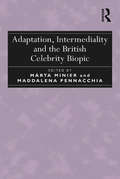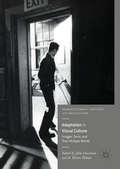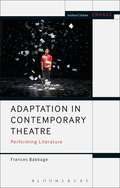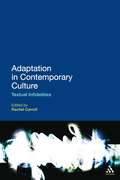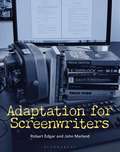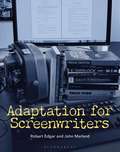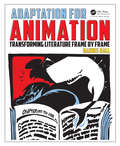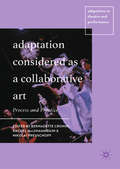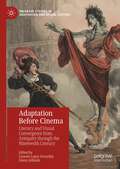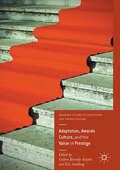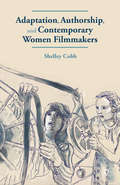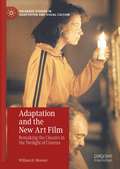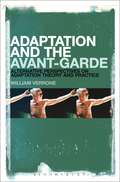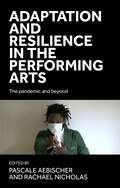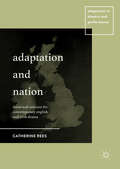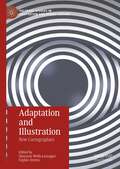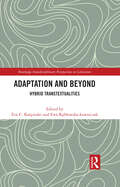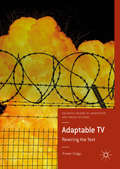- Table View
- List View
Adaptation, Intermediality and the British Celebrity Biopic
by Márta Minier Maddalena PennacchiaBeginning with the premise that the biopic is a form of adaptation and an example of intermediality, this collection examines the multiplicity of 'source texts' and the convergence of different media in this genre, alongside the concurrent issues of fidelity and authenticity that accompany this form. The contributors focus on big and small screen biopics of British celebrities from the late twentieth and twenty-first centuries, attending to their myth-making and myth-breaking potential. Related topics are the contemporary British biopic's participation in the production and consumption of celebrated lives, and the biopic's generic fluidity and hybridity as evidenced in its relationship to such forms as the bio-docudrama. Offering case studies of film biographies of literary and cultural icons, including Elizabeth I, Elizabeth II, Diana Princess of Wales, John Lennon, Shakespeare, Jane Austen, Beau Brummel, Carrington and Beatrix Potter, the essays address how British identity and heritage are interrogated in the (re)telling and showing of these lives, and how the reimagining of famous lives for the screen is influenced by recent processes of manufacturing celebrity.
Adaptation, Intermediality and the British Celebrity Biopic
by Márta Minier Maddalena PennacchiaBeginning with the premise that the biopic is a form of adaptation and an example of intermediality, this collection examines the multiplicity of 'source texts' and the convergence of different media in this genre, alongside the concurrent issues of fidelity and authenticity that accompany this form. The contributors focus on big and small screen biopics of British celebrities from the late twentieth and twenty-first centuries, attending to their myth-making and myth-breaking potential. Related topics are the contemporary British biopic's participation in the production and consumption of celebrated lives, and the biopic's generic fluidity and hybridity as evidenced in its relationship to such forms as the bio-docudrama. Offering case studies of film biographies of literary and cultural icons, including Elizabeth I, Elizabeth II, Diana Princess of Wales, John Lennon, Shakespeare, Jane Austen, Beau Brummel, Carrington and Beatrix Potter, the essays address how British identity and heritage are interrogated in the (re)telling and showing of these lives, and how the reimagining of famous lives for the screen is influenced by recent processes of manufacturing celebrity.
Adaptation in Visual Culture: Images, Texts, and Their Multiple Worlds
by Julie Grossman R. Barton PalmerThis book gathers together essays written by leading scholars of adaptation studies to explore the full range of practices and issues currently of concern in the field. The chapters demonstrate how content and messaging are shared across an increasing number of platforms, whose interrelationships have become as intriguing as they are complex. Recognizing that a signature feature of contemporary culture is the convergence of different forms of media, the contributors of this book argue that adaptation studies has emerged as a key discipline that, unlike traditional literary and art criticism, is capable of identifying and analyzing the relations between source texts and adaptations created from them. Adaptation scholars have come to understand that these relations not only play out in individual case histories but are also institutional, and this collection shows how adaptation plays a key role in the functioning of cinema, television, art, and print media. The volume is essential reading for all those interested both in adaptation studies and also in the complex forms of intermediality that define contemporary culture in the 21st century.
Adaptation in Visual Culture: Images, Texts, and Their Multiple Worlds
by Julie Grossman R. Barton PalmerThis book gathers together essays written by leading scholars of adaptation studies to explore the full range of practices and issues currently of concern in the field. The chapters demonstrate how content and messaging are shared across an increasing number of platforms, whose interrelationships have become as intriguing as they are complex. Recognizing that a signature feature of contemporary culture is the convergence of different forms of media, the contributors of this book argue that adaptation studies has emerged as a key discipline that, unlike traditional literary and art criticism, is capable of identifying and analyzing the relations between source texts and adaptations created from them. Adaptation scholars have come to understand that these relations not only play out in individual case histories but are also institutional, and this collection shows how adaptation plays a key role in the functioning of cinema, television, art, and print media. The volume is essential reading for all those interested both in adaptation studies and also in the complex forms of intermediality that define contemporary culture in the 21st century.
Adaptation in Contemporary Theatre: Performing Literature (Methuen Drama Engage)
by Frances BabbageWhy are so many theatre productions adaptations of one kind or another? Why do contemporary practitioners turn so frequently to non-dramatic texts for inspiration? This study explores the fascination of novels, short stories, children's books and autobiographies for theatre makers and examines what 'becomes' of literary texts when these are filtered into contemporary practice that includes physical theatre, multimedia performance, puppetry, immersive and site-specific performance and live art.In Adaptation in Contemporary Theatre, Frances Babbage offers a series of fresh critical perspectives on the theory of adaptation in theatre-making, focusing on meditations of prose literature within contemporary performance. Individual chapters explore the significance and impact of books as physical objects within productions; the relationship between the dramatic adaptation and literary edition; storytelling on the page and in performance; literary space and theatrical space; and prose fiction reframed as 'found text' in contemporary theatre and live art. Case studies are drawn from internationally acclaimed companies including Complicite, Elevator Repair Service, Kneehigh, Forced Entertainment, Gob Squad, Teatro Kismet and Stan's Cafe.Adaptation in Contemporary Theatre is a compelling and provocative resource for anyone interested in the potential and the challenges of using prose literature as material for new theatrical performance.
Adaptation in Contemporary Theatre: Performing Literature (Methuen Drama Engage)
by Frances BabbageWhy are so many theatre productions adaptations of one kind or another? Why do contemporary practitioners turn so frequently to non-dramatic texts for inspiration? This study explores the fascination of novels, short stories, children's books and autobiographies for theatre makers and examines what 'becomes' of literary texts when these are filtered into contemporary practice that includes physical theatre, multimedia performance, puppetry, immersive and site-specific performance and live art.In Adaptation in Contemporary Theatre, Frances Babbage offers a series of fresh critical perspectives on the theory of adaptation in theatre-making, focusing on meditations of prose literature within contemporary performance. Individual chapters explore the significance and impact of books as physical objects within productions; the relationship between the dramatic adaptation and literary edition; storytelling on the page and in performance; literary space and theatrical space; and prose fiction reframed as 'found text' in contemporary theatre and live art. Case studies are drawn from internationally acclaimed companies including Complicite, Elevator Repair Service, Kneehigh, Forced Entertainment, Gob Squad, Teatro Kismet and Stan's Cafe.Adaptation in Contemporary Theatre is a compelling and provocative resource for anyone interested in the potential and the challenges of using prose literature as material for new theatrical performance.
Adaptation in Contemporary Culture: Textual Infidelities
by Rachel CarrollAdaptation in Contemporary Culture: Textual Infidelities seeks to reconfigure the ways in which adaptation is conceptualised by considering adaptation within an extended range of generic, critical and theoretical contexts. This collection explores literary, film, television and other visual texts both as 'origins' and 'adaptations' and offers new insights into the construction of genres, canons and 'classics'. Chapters investigate both 'classic' and contemporary texts by British and American authors, from Jane Austen, Edgar Allen Poe and Charles Dickens to Bret Easton Ellis, P.D James and Sarah Waters. A diverse range of literary, film and television genres is examined, from romance to science fiction, the Western to the 'women's picture' and the heritage film to postmodern pastiche. With a thematic focus on key critical paradigms for adaptation studies - fidelity, intertextuality, historicity and authorship - this collection expands the field of adaptation studies beyond its conventional focus on 'page to screen' adaptations to include film remakes, video games, biopics, fan fiction and celebrity culture.
Adaptation for Screenwriters
by Robert Edgar John MarlandDevelop the critical and creative skills to 'translate' a story from page to screen with this step-by-step guide to the process of screen adaptation you'll learn to:- interrogate a novel or short story to release its 'inner film'- convert fictional prose into visual drama- overcome the obstacles presented by different media 'languages'- approach key strategic decisions - both technical and interpretive- draft and re-draft your plot, characters and dialogue- professionally format and submit your finished scriptIn addition to examples taken from 'literary classics', contemporary novels, genre fiction, short stories, and biographical material, Marland and Edgar embrace the wider phenomenon of re-telling and updating existing stories, such as the 'appropriation' of popular figures, inter-film adaptation (sequels and 'reboots'), and development into other visual forms including graphic fiction and video games.Whether you are producing a faithful adaptation of Tolstoy's War and Peace, or planning to pair up the crime-fighting duo of Sherlock Holmes and Batman, Adaptation for Screenwriters will be your guide.
Adaptation for Screenwriters
by Robert Edgar John MarlandDevelop the critical and creative skills to 'translate' a story from page to screen with this step-by-step guide to the process of screen adaptation you'll learn to:- interrogate a novel or short story to release its 'inner film'- convert fictional prose into visual drama- overcome the obstacles presented by different media 'languages'- approach key strategic decisions - both technical and interpretive- draft and re-draft your plot, characters and dialogue- professionally format and submit your finished scriptIn addition to examples taken from 'literary classics', contemporary novels, genre fiction, short stories, and biographical material, Marland and Edgar embrace the wider phenomenon of re-telling and updating existing stories, such as the 'appropriation' of popular figures, inter-film adaptation (sequels and 'reboots'), and development into other visual forms including graphic fiction and video games.Whether you are producing a faithful adaptation of Tolstoy's War and Peace, or planning to pair up the crime-fighting duo of Sherlock Holmes and Batman, Adaptation for Screenwriters will be your guide.
Adaptation for Animation: Transforming Literature Frame by Frame
by Hannes RallTalented animation artists often neglect successful storytelling in favor of strong visuals, but now you can have both with this complete guide to adaptation for animation. Veteran independent filmmaker Hannes Rall teaches you how to draw and adapt inspiration from copyright-free materials like fairy tales, myths, and classic literature, making it easier than ever to create your own compelling narrative. Particular focus is given to making the adequate narrative and visual choices when transferring a text from page to screen: How to create a successful adaptation. With sections on subjects like transcultural adaptations, visual poetry and production design, this book is just the right mix of practical advice, lavish illustrations, and industry case studies to give you everything you need to start adapting your story today. Key features: Learn to apply concepts of adapting classic and modern literature for animation in different techniques Exclusive interviews with animation legends Giannalberto Bendazzi, John Canemaker, Ishu Patel and Georges Schwizgebel Lavishly illustrated with 325 color images (mostly never published before) that give thrilling insights into the visual development of award-winning animated adaptations
Adaptation for Animation: Transforming Literature Frame by Frame
by Hannes RallTalented animation artists often neglect successful storytelling in favor of strong visuals, but now you can have both with this complete guide to adaptation for animation. Veteran independent filmmaker Hannes Rall teaches you how to draw and adapt inspiration from copyright-free materials like fairy tales, myths, and classic literature, making it easier than ever to create your own compelling narrative. Particular focus is given to making the adequate narrative and visual choices when transferring a text from page to screen: How to create a successful adaptation. With sections on subjects like transcultural adaptations, visual poetry and production design, this book is just the right mix of practical advice, lavish illustrations, and industry case studies to give you everything you need to start adapting your story today. Key features: Learn to apply concepts of adapting classic and modern literature for animation in different techniques Exclusive interviews with animation legends Giannalberto Bendazzi, John Canemaker, Ishu Patel and Georges Schwizgebel Lavishly illustrated with 325 color images (mostly never published before) that give thrilling insights into the visual development of award-winning animated adaptations
Adaptation Considered as a Collaborative Art: Process and Practice (Adaptation in Theatre and Performance)
by Bernadette Cronin Rachel MagShamhráin Nikolai PreuschoffThis book examines the processes of adaptation across a number of intriguing case studies and media. Turning its attention from the 'what' to the 'how' of adaptation, it serves to re-situate the discourse of adaptation studies, moving away from the hypotheses that used to haunt it, such as fidelity, to questions of how texts, authors and other creative practitioners (always understood as a plurality) engage in dialogue with one another across cultures, media, languages, genders and time itself. With fifteen chapters across fields including fine art and theory, drama and theatre, and television, this interdisciplinary volume considers adaptation across the creative and performance arts, with a single focus on the collaborative.
Adaptation Before Cinema: Literary and Visual Convergence from Antiquity through the Nineteenth Century (Palgrave Studies in Adaptation and Visual Culture)
by Lissette Lopez Szwydky Glenn JellenikAdaptation Before Cinema highlights a range of pre-cinematic media forms, including theater, novelization, painting and illustration, transmedia art, children’s media, and other literary and visual culture. The book expands the primary scholarly audience of adaptation studies from film and media scholars to literary scholars and cultural critics working across a range of historical periods, genres, forms, and media. In doing so, it underscores the creative diversity of cultural adaptation practiced before cinema came to dominate the critical conversation on adaptation. Collectively, the chapters construct critical bridges between literary history and contemporary media studies, foregrounding diverse practices of adaptation and providing a platform for innovative critical approaches to adaptation, appropriation, or transmedia storytelling popular from the Middle Ages through the invention of cinema. At the same time, they illustrate how these forms of adaptation not only influenced the cinematic adaptation industry of the twentieth century but also continue to inform adaptation practices in the twenty-first century transmedia landscape. Written by scholars with expertise in historical, literary, and cultural scholarship ranging from the medieval period through the nineteenth century, the chapters use discourses developed in contemporary adaptation studies to shed new lights on their respective historical fields, authors, and art forms.
Adaptation, Awards Culture, and the Value of Prestige (Palgrave Studies in Adaptation and Visual Culture)
by Colleen Kennedy-Karpat and Eric SandbergThis book explores the intersection between adaptation studies and what James F. English has called the “economy of prestige,” which includes formal prize culture as well as less tangible expressions such as canon formation, fandom, authorship, and performance. The chapters explore how prestige can affect many facets of the adaptation process, including selection, approach, and reception. The first section of this volume deals directly with cycles of influence involving prizes such as the Pulitzer, the Man Booker, and other major awards. The second section focuses on the juncture where adaptation, the canon, and awards culture meet, while the third considers alternative modes of locating and expressing prestige through adapted and adaptive intertexts. This book will be of interest to students and scholars of adaptation, cultural sociology, film, and literature.
Adaptation, Authorship, and Contemporary Women Filmmakers
by S. CobbA lively discussion of costume dramas to women's films, Shelley Cobb investigates the practice of adaptation in contemporary films made by women. The figure of the woman author comes to the fore as a key site for the representation of women's agency and the authority of the woman filmmaker.
Adaptation and the New Art Film: Remaking the Classics in the Twilight of Cinema (Palgrave Studies in Adaptation and Visual Culture)
by William H. MooneySince the 1990s, the expropriation of canonical works of cinema has been a fundamental dimension of art-film exploration. Rainer Werner Fassbinder provides an early model of open adaptation of film classics, followed ever more boldly by the Coen Brothers, Chantal Akerman, Alex Carax, Todd Haynes, Florian Henckel von Donnersmarck, Baz Luhrmann, and Olivier Assayas. This book devotes chapters to each of these directors to examine how their films redeploy landmark precursors such as City Lights (1931), Citizen Kane (1941), Rome Open City (1945), All About Eve (1950), and Vertigo (1958) in order to probe our psychological, philosophical, and historical situations in a postmodern société du spectacle. In broadly diverse ways, each of these directors complicates received notions of the past and its representation, while probing the transformative media evolution and dislocation of the present, in film art and in society.
Adaptation and the Avant-Garde: Alternative Perspectives on Adaptation Theory and Practice
by William VerroneAdaptations have occurred regularly since the beginning of cinema, but little recognition has been given to avant-garde adaptations of literary or other texts. This compelling study corrects such omissions by detailing the theory and practice of alternative adaptation practices from major avant-garde directors. Avant-Garde films are often relegated to the margins because they challenge our traditional notions of what film form and style can accomplish. Directors who choose to adapt previous material run the risk of severe critical dismay; making films that are highly subjective interpretations or representations of existing texts takes courage and foresight. An avant-garde adaptation provokes spectators by making them re-think what they know about film itself, just as much as the previous source material.Adaptation and the Avant-Garde examines films by Peter Greenaway, Jean-Luc Godard, Guy Maddin, Jan Svankmajer and many others, offering illuminating insights and making us reconsider the nature of adaptation, appropriation, borrowing, and the re-imagining of previous sources.
Adaptation and the Avant-Garde: Alternative Perspectives on Adaptation Theory and Practice
by William VerroneAdaptations have occurred regularly since the beginning of cinema, but little recognition has been given to avant-garde adaptations of literary or other texts. This compelling study corrects such omissions by detailing the theory and practice of alternative adaptation practices from major avant-garde directors. Avant-Garde films are often relegated to the margins because they challenge our traditional notions of what film form and style can accomplish. Directors who choose to adapt previous material run the risk of severe critical dismay; making films that are highly subjective interpretations or representations of existing texts takes courage and foresight. An avant-garde adaptation provokes spectators by making them re-think what they know about film itself, just as much as the previous source material.Adaptation and the Avant-Garde examines films by Peter Greenaway, Jean-Luc Godard, Guy Maddin, Jan Svankmajer and many others, offering illuminating insights and making us reconsider the nature of adaptation, appropriation, borrowing, and the re-imagining of previous sources.
Adaptation and resilience in the performing arts: The pandemic and beyond (The pandemic and beyond)
by Pascale Aebischer Rachael NicholasThis book offers insights into some of the digital innovations, structural adaptations and analogue solutions that enabled live performance in the UK to survive through the COVID-19 pandemic. It provides evidence of values-led policies and practices that have improved the wellbeing of the creative workforce and have increased access to live performance. Through sections that address digital innovations, workforce resilience and programming live performances outdoors and in community settings, this book provides practical insights into the challenges live performance faced during the pandemic. It shows how, in order to survive, individuals and companies within the sector drew on the creativity and resourcefulness of its workforce, and on new and existing networks. In these accounts, the pandemic functioned as catalyst for technological innovations, stock-taking regarding exploitative industry structures, and a re-valuing of the role of live performance for community-building.
Adaptation and resilience in the performing arts: The pandemic and beyond (The pandemic and beyond)
by Pascale Aebischer and Rachael NicholasThis book offers insights into some of the digital innovations, structural adaptations and analogue solutions that enabled live performance in the UK to survive through the COVID-19 pandemic. It provides evidence of values-led policies and practices that have improved the wellbeing of the creative workforce and have increased access to live performance. Through sections that address digital innovations, workforce resilience and programming live performances outdoors and in community settings, this book provides practical insights into the challenges live performance faced during the pandemic. It shows how, in order to survive, individuals and companies within the sector drew on the creativity and resourcefulness of its workforce, and on new and existing networks. In these accounts, the pandemic functioned as catalyst for technological innovations, stock-taking regarding exploitative industry structures, and a re-valuing of the role of live performance for community-building.
Adaptation and Nation: Theatrical Contexts for Contemporary English and Irish Drama (Adaptation in Theatre and Performance)
by Catherine ReesThis book focuses on modern theatrical adaptations that rework classic plays in new British and Irish settings. It explores these shifted national contexts and examines what they might reveal about the political and cultural climate of the new setting. In examining the modern setting alongside the country of the original text, it also reveals fascinating resonances between two different national contexts. The book discusses five British and Irish playwrights and their current adaptations, examining well-known dramatists such as Martin McDonagh, Sarah Kane and Brian Friel, while analysing some of their less well-known plays, offering a novel examination of the adaptation process. The book further provides an insightful commentary on some significant events of the twentieth century in Britain and Ireland, such as the historic Labour victory of 1945 and scandals in the Royal Family since the 1990s. This book will appeal to theatre and performance enthusiasts, as well as students and scholars of both theatre and adaptation.
Adaptation and Illustration: New Cartographies (Palgrave Studies in Adaptation and Visual Culture)
by Shannon Wells-Lassagne Sophie AymesThis collection examines the relationship between illustration and adaptation from an intermedial and transcultural perspective. It aims to foster a dialogue between two fields that co-exist without necessarily acknowledging advances in each other’s domains, providing an argument for defining illustration as a form of adaptation, as well as an intermedial practice that redefines what we mean by adaptation. The volume embraces both a specific and an extended definition of illustration that accounts for its inclusion among the web of adaptive practices that developed with the rise of new media and intermediality. The contributors explore how crossovers may contribute to reappraise their objects, and rely on a transmedial and interdisciplinary corpus exploring the boundaries between illustration and other media such as texts, graphic novels, comics, theatre, film and mobile applications. Arguably adaptation, like intermediality, is an umbrella term that covers a variety of practices and products, and both of them have been shaped by intense debates over their boundaries and internal definitions. Illustration belongs to each of these areas, and this volume proposes insight into how illustration not only relates to adaptation and intermediality but how each field is redefined, enriched and also challenged by such interactions.
Adaptation and Beyond: Hybrid Transtextualities (Routledge Interdisciplinary Perspectives on Literature)
by Eva C. Karpinski Ewa Kębłowska-ŁawniczakThis interdisciplinary collection focuses on recent adaptations, both experimental and popular, that put hybridity, transtextuality, and transmediality at play. It reframes adaptation in terms of the transmedia concept of "world-building," which accurately captures the complexity and multidirectionality of contemporary scattered and ubiquitous practices of adaptation. The Editors argue that the process of moving stories or their elements across different media platforms and repurposing them for new uses results in the production of hybrid transtextualities. The book demonstrate how hybrid textualities augment narrative and literary forms as goals of their world-building, finding unexpected sites of cross-pollination, expansion, and appropriation in spoken-word and dance performance, (auto)biographical comics, advertising, Chinese Kun opera, and popular song lyrics. This yoking of hybridity and transmediality yields not only diversified and often commercialized aesthetic forms but also enables the emergence a unique cultural space in-between, a mezzaterra capable of addressing current political issues and mobilizing broader audiences
Adaptation and Beyond: Hybrid Transtextualities (Routledge Interdisciplinary Perspectives on Literature)
This interdisciplinary collection focuses on recent adaptations, both experimental and popular, that put hybridity, transtextuality, and transmediality at play. It reframes adaptation in terms of the transmedia concept of "world-building," which accurately captures the complexity and multidirectionality of contemporary scattered and ubiquitous practices of adaptation. The Editors argue that the process of moving stories or their elements across different media platforms and repurposing them for new uses results in the production of hybrid transtextualities. The book demonstrate how hybrid textualities augment narrative and literary forms as goals of their world-building, finding unexpected sites of cross-pollination, expansion, and appropriation in spoken-word and dance performance, (auto)biographical comics, advertising, Chinese Kun opera, and popular song lyrics. This yoking of hybridity and transmediality yields not only diversified and often commercialized aesthetic forms but also enables the emergence a unique cultural space in-between, a mezzaterra capable of addressing current political issues and mobilizing broader audiences
Adaptable TV: Rewiring the Text (Palgrave Studies in Adaptation and Visual Culture)
by Yvonne GriggsThis book focuses on the significantly under-explored relationship between televisual culture and adaptation studies in what is now commonly regarded as the ‘Golden Age’ of contemporary TV drama. Adaptable TV: Rewiring the Text does not simply concentrate on traditional types of adaptation, such as reboots, remakes and sequels, but broadens the scope of enquiry to examine a diverse range of experimental adaptive types that are emerging within an ever-changing TV landscape. With a particular focus on the serial narrative form, and with case studies that include Penny Dreadful, Fargo, The Night Of and Orange is the New Black, this study is essential reading for anyone who is interested in the complex interplay between television studies and adaptation studies.
